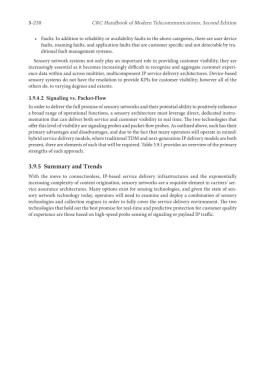Page 447 - Handbook of Modern Telecommunications
P. 447
3-238 CRC Handbook of Modern Telecommunications, Second Edition
• Faults: In addition to reliability or availability faults in the above categories, there are user device
faults, roaming faults, and application faults that are customer specific and not detectable by tra-
ditional fault management systems.
Sensory network systems not only play an important role in providing customer visibility, they are
increasingly essential as it becomes increasingly difficult to recognize and aggregate customer experi-
ence data within and across multitier, multicomponent IP service delivery architectures. Device-based
sensory systems do not have the resolution to provide KPIs for customer visibility; however all of the
others do, to varying degrees and extents.
3.9.4.2 Signaling vs. Packet-Flow
In order to deliver the full promise of sensory networks and their potential ability to positively influence
a broad range of operational functions, a sensory architecture must leverage direct, dedicated instru-
mentation that can deliver both service and customer visibility in real time. The two technologies that
offer this level of visibility are signaling probes and packet-flow probes. As outlined above, each has their
primary advantages and disadvantages, and due to the fact that many operators still operate in mixed/
hybrid service delivery models, where traditional TDM and next-generation IP delivery models are both
present, there are elements of each that will be required. Table 3.9.1 provides an overview of the primary
strengths of each approach.
3.9.5 Summary and Trends
With the move to connectionless, IP-based service delivery infrastructures and the exponentially
increasing complexity of content origination, sensory networks are a requisite element in carriers’ ser-
vice assurance architectures. Many options exist for sensing technologies, and given the state of sen-
sory network technology today, operators will need to examine and deploy a combination of sensory
technologies and collection engines in order to fully cover the service delivery environment. The two
technologies that hold out the best promise for real-time and predictive protection for customer quality
of experience are those based on high-speed probe sensing of signaling or payload IP traffic.

